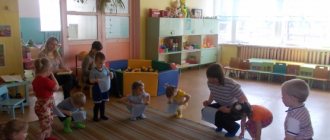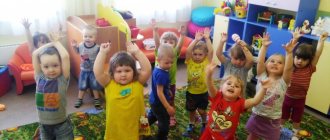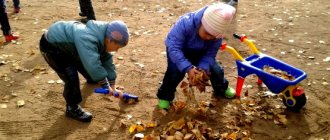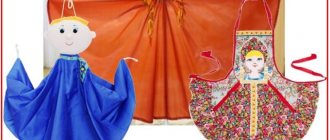Classification of outdoor games
The variety of tasks for conducting this type of fun makes it necessary to systematize outdoor games by type, namely:
- to develop the ability to run and jump (it is difficult for younger preschoolers to coordinate their movements, in particular, to move in one direction);
- for orientation in space;
- to develop balance (for example, in games of walking on a limited surface to rhythmic lines);
- to strengthen the muscles of the torso, back, spine, arch of the foot;
- for imitation;
In imitation games, children not only try to repeat the movements of animals and adults, but also imitate different sounds.
- with a ball (including for the formation of partnerships between children);
- to master the skill of climbing;
- on the development of attention.
Based on their place in the educational process, games for children aged 1.5–3 years can be divided into four types:
- fun for a walk (carried out on the street);
- physical education breaks (organized during classes for relaxation and change of activities);
- leisure activity (for spending time outside of classes - on a walk, at matinees, in the process of independent activities);
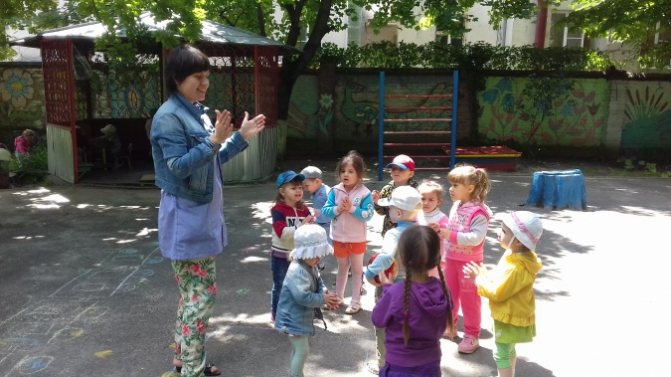
In the warm season, outdoor games are the main activity during a walk.
- folk game (to get acquainted with the traditions and customs of your people).
Based on the types, we can conclude that outdoor activities are carried out at every lesson not only in the form of a physical education break, but also in separate lessons: physical education, choreography (if this discipline is included in the preschool educational program), music class.
Analysis and self-analysis of outdoor games
Both types of analysis are carried out according to the same scheme, with the only difference being that the analysis is carried out by observers, whose role is played by colleagues and methodologists, and self-analysis is carried out by the teacher himself. The first assess the level of methodological literacy of the teacher when conducting the game and the preparation of children in the process of performing game actions. The teacher, through self-analysis, helps himself to identify organizational shortcomings in his work. In addition, both self-analysis and analysis assess the level of creating a positive microclimate in the children's team.
Parsing protocol
- Game start time.
- Number of players.
- Correspondence of the goals and objectives of the fun to the age of the kids.
- Who initiates the game? In the first junior group, this role is always played by the teacher.
- Techniques for creating interest in the game (riddles, explanations, showing pictures).
- Logical explanation (repetition) of the rules of the game. It is important to note whether the teacher named the location of the players and listed the attributes that the kids will need. It is important not to be distracted by comments during these explanations.
- Children’s acceptance of the rules of the game, reasons for violations (if any).

In the same paragraph, the reasons for the aggressive behavior of children during the game are analyzed, if such manifestations were
- Assessment of the level of preparation of attributes (done by the teacher himself, ready-made).
- The way to distribute roles in the game. For the first junior group, the teacher distributes them himself. In the second half of the year, it is possible to use counters to identify the characters in the game.
- The level of children’s performance of game tasks (how they overcome difficulties, whether they provide assistance, whether they show restraint).
- How developed are children's agility, speed, and endurance? It is important that kids not only perform playful movements, but also take the initiative to create combinations of actions.
- Compliance with ethical standards of behavior during the game. This criterion evaluates the manifestations of mutual assistance of young pupils in relation to each other, the development of the ability to find a common language, and the ability to give in.
- Assessing the role of the educator. How appropriate and logical are the teacher’s advice during the game, how often does he take on the role of observer.
- How does the summing up take place: does the teacher celebrate the distinguished children, does he praise everyone.
- Duration of the game and number of repetitions.
Outdoor games in the first junior group are aimed at developing physical abilities and strengthening the health of children. In addition, carrying out such fun in classes and during leisure time contributes to the socialization and development of speech in children aged 1.5–3 years. To successfully implement the assigned tasks, the teacher must take into account all the requirements for organizing and conducting outdoor games, as well as apply the maximum of his methodological knowledge to develop a detailed outline of gaming activities.
Goals and objectives of outdoor games
In the first junior group, special attention is paid to games that require varying degrees of mobility for children. Such fun is the main form of fulfilling the mission of the educational process, which consists in:
- ensuring the versatile development of children (physical, emotional-volitional, spiritual);
- health promotion;
- developing the skill to follow the rules of the game;
- stimulating the desire to play with friends and adults;
- nurturing the need to be part of a team.
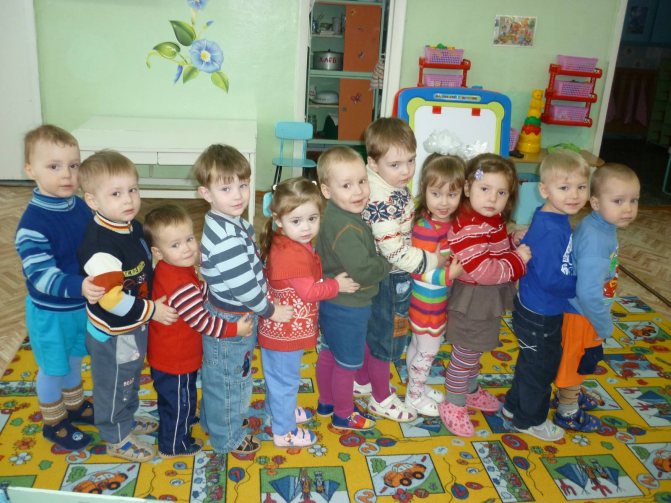
Outdoor games are a collective type of work that fosters a spirit of cooperation in children.
The implementation of the set goals in the first junior group is possible with the systematic and consistent solution of the tasks of conducting outdoor games:
- strengthening the musculoskeletal system;
- mastering the skill of performing simple motor exercises together with a teacher and peers, accompanied by a simple plot;
- improving basic movements (running, walking at different paces, throwing and rolling a ball, jumping);
- learning to express movements through imitation (jumping like bunnies, drinking water like chickens, etc.);
- training the ability not to lose orientation in the playing space;
- practice the skill of moving one after another and completing the movement at a certain signal from the leader (teacher);
- developing the skill of coordinating one’s actions with the rules of the game and other participants;
- encouraging independence.
